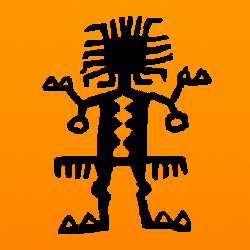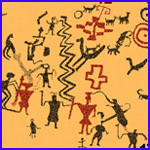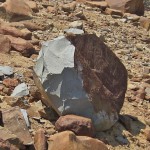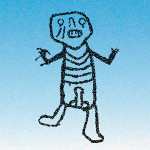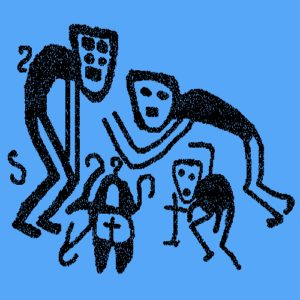 Este artículo investiga cuatro iconos raros del sitio de arte rupestre de Ariquilda en el desierto de Atacama en el norte de Chile. Se trata de un grupo de figuras antropomórficas que muestran una actitud muy específica y tres otros motivos muy enigmáticos. He nombrado estos cuatro motivos: ‘Los Hombres Torcidos’, ‘Los Cueros’ y ‘Las Gafas junto con Las Figuras Triangulares’. De nuevo estos iconos confirman el estatus especial de Ariquilda en el arte rupestre andino (véanse también ‘The Avian Staff Bearer’ y ‘Icons That Travel’, ambos publicados en TRACCE).
Este artículo investiga cuatro iconos raros del sitio de arte rupestre de Ariquilda en el desierto de Atacama en el norte de Chile. Se trata de un grupo de figuras antropomórficas que muestran una actitud muy específica y tres otros motivos muy enigmáticos. He nombrado estos cuatro motivos: ‘Los Hombres Torcidos’, ‘Los Cueros’ y ‘Las Gafas junto con Las Figuras Triangulares’. De nuevo estos iconos confirman el estatus especial de Ariquilda en el arte rupestre andino (véanse también ‘The Avian Staff Bearer’ y ‘Icons That Travel’, ambos publicados en TRACCE).
Tag Archive for Andes
Petroglifos Únicos en Ariquilda, Chile
Los Petroglifos de Tintín, Sihuas, Arequipa, Perú
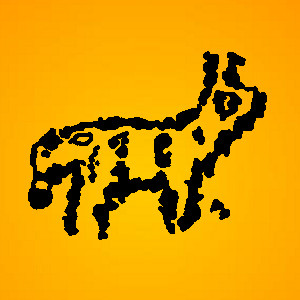 Tintín es un sitio pequeño de arte rupestre en el valle del Río Sihuas en el sur de Perú. El sitio, también conocido como Cerro Blanco y Pisanay tiene algunas rocas con petroglifos. La Roca Principal es bastante grande y tiene un gran cantidad de imágenes. Un video muestra los petroglifos en detalle.
Tintín es un sitio pequeño de arte rupestre en el valle del Río Sihuas en el sur de Perú. El sitio, también conocido como Cerro Blanco y Pisanay tiene algunas rocas con petroglifos. La Roca Principal es bastante grande y tiene un gran cantidad de imágenes. Un video muestra los petroglifos en detalle.
Tintín is a small rock site in the Sihuas River valley in southern Peru. The site, also known as Cerro Blanco and Pisanay has some rocks with petroglyphs. The Main Rock is quite large and has a lot of images. A video shows those petroglyphs in detail.
By Maarten van Hoek Read more
The Petroglyphs of Chumbenique, Zaña, Peru
 This short paper, together with a YouTube video, describes and illustrates the rock art discovered in the valley of the Río Zaña in northern Peru. The petroglyphs were first described (in Spanish) by archaeologist Edgar Bracamonte in 2014. Because that is the only brief report that exists at the moment, I have written a brief paper in English, while the video (which is in Spanish) offers the illustrations as well as shots of the environment. The locals at Chumbenique know about ‘their’ rock art and I hope that they will encourage locals of their village and of the valley and of course every visitor to Chumbenique to respect and protect this sacred site.
This short paper, together with a YouTube video, describes and illustrates the rock art discovered in the valley of the Río Zaña in northern Peru. The petroglyphs were first described (in Spanish) by archaeologist Edgar Bracamonte in 2014. Because that is the only brief report that exists at the moment, I have written a brief paper in English, while the video (which is in Spanish) offers the illustrations as well as shots of the environment. The locals at Chumbenique know about ‘their’ rock art and I hope that they will encourage locals of their village and of the valley and of course every visitor to Chumbenique to respect and protect this sacred site.
By Maarten van Hoek
Los Bordes Aserrados de las Rocas de Chuquillanqui, Perú
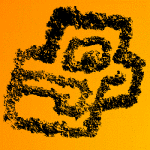 A menudo un sitio de arte rupestre tiene una característica muy específica que además es a menudo único en ese sitio. Este artículo presenta un elemento tan distintivo en el sitio rupestre de Chuquillanqui en la cuenca del Río Chicama en el norte de Perú.
A menudo un sitio de arte rupestre tiene una característica muy específica que además es a menudo único en ese sitio. Este artículo presenta un elemento tan distintivo en el sitio rupestre de Chuquillanqui en la cuenca del Río Chicama en el norte de Perú.
Often a rock art site has a very specific feature that moreover is often unique to that site. This paper presents such a distinguishing element at the petroglyph site of Chuquillanqui in the Chicama drainage of northern Peru.
by Maarten van Hoek
Kuntur Wasi, Peru: Architectural Art or Rock Art ?
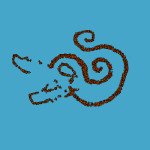 Often we find pecked or scratched images on walls of rocks that are part of ancient structures, ranging from simple circular huts to intricate temple complexes. In many cases the rocks that are used have been smoothened before (or after) they were incorporated. In most instances it is clear that those images have been added after the smoothening and after the incorporation of the stones into the structure. Some of them may definitely be regarded as true rock art and not as architectural art, but a few images are ambiguous in this respect. This short paper discusses one such controversial image on a menacing monolith at Kuntur Wasi in northern Peru.
Often we find pecked or scratched images on walls of rocks that are part of ancient structures, ranging from simple circular huts to intricate temple complexes. In many cases the rocks that are used have been smoothened before (or after) they were incorporated. In most instances it is clear that those images have been added after the smoothening and after the incorporation of the stones into the structure. Some of them may definitely be regarded as true rock art and not as architectural art, but a few images are ambiguous in this respect. This short paper discusses one such controversial image on a menacing monolith at Kuntur Wasi in northern Peru.
By Maarten van Hoek
The Frontal Insignia-Tumi
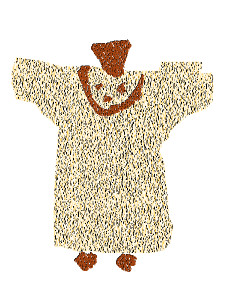 The Desert Andes (the westernmost coastal strip of South America) is very rich in rock art sites. In rare cases specific images occur at selected sites, often separated by long streches of the desert. Two telling examples are the Avian Staff Bearer and the The Enigmatic Traveller (both published in TRACCE). This study examines another “travelling” icon: The Frontal Insignia-Tumi that is found from Tamentica in the south to – surprisingly – Toro Muerto in the north of the Study Area, a distance of no less than 630 km (as the crow flies).
The Desert Andes (the westernmost coastal strip of South America) is very rich in rock art sites. In rare cases specific images occur at selected sites, often separated by long streches of the desert. Two telling examples are the Avian Staff Bearer and the The Enigmatic Traveller (both published in TRACCE). This study examines another “travelling” icon: The Frontal Insignia-Tumi that is found from Tamentica in the south to – surprisingly – Toro Muerto in the north of the Study Area, a distance of no less than 630 km (as the crow flies).
By Maarten van Hoek
Sobre Dibujos de Arte Rupestre (Andino)
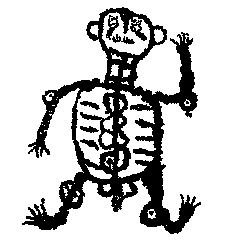 The essence of every rock art study must be the image. In most cases the image that we observe is not quite the same as manufactured and/or intended by prehistoric people. It is altered by weathering, erosion and all sorts of anthropic activities. Yet, the resulting image is the only source to use. The best thing to do is to photograph the image, but if one makes a drawing of the image, it should be as correct as possible. Yet, many rock art researchers produce and publish drawings that are not correct. Consequently, their interpretations will often be incorrect. This study discusses some examples of incorrect drawings and offers some recommendations.
The essence of every rock art study must be the image. In most cases the image that we observe is not quite the same as manufactured and/or intended by prehistoric people. It is altered by weathering, erosion and all sorts of anthropic activities. Yet, the resulting image is the only source to use. The best thing to do is to photograph the image, but if one makes a drawing of the image, it should be as correct as possible. Yet, many rock art researchers produce and publish drawings that are not correct. Consequently, their interpretations will often be incorrect. This study discusses some examples of incorrect drawings and offers some recommendations.
by Maarten van Hoek
Icons That Travel
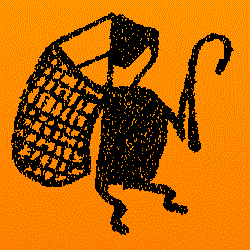 The Atacama Desert and the Andes in South America are crisscrossed by myriads of paths and tracks. Often those tracks are easily seen in Google Earth as broad bands. Also rock art images narrate of such travels. They mainly depict camelids guided by people. In rare instances however a specific kind of traveller has been depicted on the rocks. I have labelled it ‘The Enigmatic Traveller‘. In this study I describe the distribution of this icon, compare it with similar images and try to explain the meaning of the enigmatic position of the arms of this figure.
The Atacama Desert and the Andes in South America are crisscrossed by myriads of paths and tracks. Often those tracks are easily seen in Google Earth as broad bands. Also rock art images narrate of such travels. They mainly depict camelids guided by people. In rare instances however a specific kind of traveller has been depicted on the rocks. I have labelled it ‘The Enigmatic Traveller‘. In this study I describe the distribution of this icon, compare it with similar images and try to explain the meaning of the enigmatic position of the arms of this figure.
By Maarten van Hoek
The Avian Staff Bearer
This paper investigates a well-known but rare icon from the rock art of the Atacama Desert. It concerns a group of anthropomorphic figures displaying a very specific bird-related element. For that reason Juan Chacama and Gustavo Espinosa speak of ‘hombres-falcónidas’, ‘raptor-men’, to describe this class of anthropomorphic figures. Remarkably, their interpretation seems to be generally ignored by several archaeologists and rock art investigators. This study presents a revaluation of the theory put forward by Juan Chacama and Gustavo Espinosa in 1997.
By Maarten van Hoek
Chiza, Interpreting Digitally Restored Petroglyphs
The goal of this paper is to offer the interested reader a digital restoration and interpretation of the images of a vandalized petroglyph boulder located in the Atacama Desert, northern Chile. Its damaged face underscores the urgent necessity to ([photo])graphic record rock art sites in general. It is hoped that very soon a complete survey will be made of the Chiza petroglyph site and that the official survey will be made available to rock art researchers.
by Maarten van Hoek
The Motocachy Pampa Disaster, Peru
The UNESCO’s World Heritage List now registers almost a thousand properties. Only two percent of the World Heritage List comprises rock art sites. Regrettably 44 of those properties are in danger, which proves that being on the World Heritage List is not a guarantee that nothing will endanger the site. I will focus the discussion mainly on rock art sites in the deserts of western Peru.
by Maarten van Hoek – rockart@home.nl
The Carcancha and the Apu
This book is the first to explain the exceptional relationship between unique images of skeleton-anthropomorphic petroglyphs and one of the most important Sacred Mountains of the Andes.
El sitio de arte rupestre de Alto de Pitis es el más importante en el Valle de Majes por su unión única con una Montaña Sagrada.
by Maarten van Hoek
Read more
